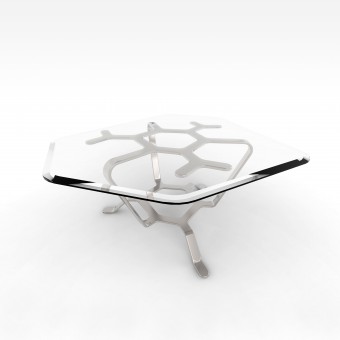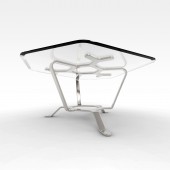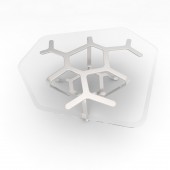
| THE AWARD |
| CATEGORIES |
| REGISTRATION |
| SUBMIT YOUR WORK |
| ENTRY INSTRUCTIONS |
| TERMS & CONDITIONS |
| PUBLICATIONS |
| DATES & FEES |
| METHODOLOGY |
| CONTACT |
| WINNERS |
| PRESS ROOM |
| GET INVOLVED |
| DESIGN PRIZE |
| DESIGN STORE |
| THE AWARD | JURY | CATEGORIES | REGISTRATION | PRESS | WINNERS | PUBLICATIONS | ENTRY INSTRUCTIONS |
Dendrone Table by Javier Olmeda Raya |
Home > Winners > Design #32058 >Interview |
 |
|
FS: What is the main principle, idea and inspiration behind your design?
JO: Dendrone is a table inspired by the structure of a neuron. Dendrites, terminal receptors found in nerve cells, try to reach out and connect with other cells. The table’s shape resemble those terminals.
FS: What has been your main focus in designing this work? Especially what did you want to achieve?
JO: My main focus is always trying to create parametric objects which can yield families or similar items with relative ease. Based on geometrical parameters, I can manipulate the final shape according to specific needs.
FS: What are your future plans for this award winning design?
JO: I plan to reproduce it as much as I can.
FS: How long did it take you to design this particular concept?
JO: About a month or so.
FS: Why did you design this particular concept? Was this design commissioned or did you decide to pursuit an inspiration?
JO: It was partly a commission by a private client, and partly my own research on natural formations and structures.
FS: Is your design being produced or used by another company, or do you plan to sell or lease the production rights or do you intent to produce your work yourself?
JO: It is being produced by my company in association with other manufacturers. But if the opportunity comes, and under favorable conditions, I would lease the production rights to other companies.
FS: What made you design this particular type of work?
JO: It’s part of my own process as a designer to keep exploring and describing new ways for designing objects with the available tools I have at hand. I’ve always been interested in the human brain and how it works, so one thing leads to another and all of a sudden we come up with beautiful designs.
FS: Where there any other designs and/or designers that helped the influence the design of your work?
JO: Yes, I don’t work alone, I have a team of designers and fabricators which help and contribute to the overall design.
FS: Who is the target customer for his design?
JO: It’s not intended to a particular target customer.
FS: How did you come up with the name for this design? What does it mean?
JO: Sometimes the name surfaces during research or initial design phases, but this one came after the design was completed. I saw an article on the human brain in a National Geographic Magazine and came across with a neuron’s diagram. I was struck with my design’s resemblance with a neuron and found the name dendrites. I further looked its etymology and it comes form the greek language. It means a short branching structure.
FS: Which design tools did you use when you were working on this project?
JO: I usually work in a parametric environment called Grasshopper for Rhinoceros. There I establish a set of geometrical associations to have control over different aspects of design, such as shape, width, height, and extension of the various components.
FS: What is the most unique aspect of your design?
JO: The ability to adapt its shape to any condition without having to re-design everything. A simple tweak here or there and a new design emerges, similar to the one before, but with slight changes.
FS: Who did you collaborate with for this design? Did you work with people with technical / specialized skills?
JO: My partners in the studio. There are some architects, sculptors, artists and designers within our team.
FS: What is the role of technology in this particular design?
JO: Digital technology allows us to come up with multiple solutions before entering into production phase. It also enables us to see how is it going to look like before actually building it.
FS: Is your design influenced by data or analytical research in any way? What kind of research did you conduct for making this design?
JO: Research was done primarily on Voronoi diagrams and how we can divide space in a way similar to how Nature has done for millions of years. After that, the striking resemblance with neurons added another layer of data. Working in a parametric environment allows us to design with mathematical operations that are turned into geometrical descriptions.
FS: What are some of the challenges you faced during the design/realization of your concept?
JO: The main challenge was achieving a light, fluid piece made of a fully functional parametric 3D model, and then taking it into production phase, even though its shape looks difficult to achieve, it’s rather simple to build.
FS: How did you decide to submit your design to an international design competition?
JO: A friend of mine, who also is a designer and won an award last year encouraged me to submit my design.
FS: What did you learn or how did you improve yourself during the designing of this work?
JO: There’s always room for learning from every design we make. In terms of geometry, we’re more close to designing things that can be easily produced within the industrial realm. In terms of production, maximizing the use of materials and minimizing production costs makes us better designers.
FS: Any other things you would like to cover that have not been covered in these questions?
JO: No.
FS: Thank you for providing us with this opportunity to interview you.
A' Design Award and Competitions grants rights to press members and bloggers to use parts of this interview. This interview is provided as it is; DesignPRWire and A' Design Award and Competitions cannot be held responsible for the answers given by participating designers.
| SOCIAL |
| + Add to Likes / Favorites | Send to My Email | Comment | View Press-Release |




